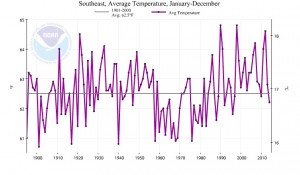There has been a lot of discussion in the news lately about differences in temperature trends between surface temperatures measured by thermometers and satellite-based temperatures measured by sensing radiation from space. A lot of climate skeptics talk about adjustments made to the surface temperatures, but may not realize that satellite temperatures are also adjusted to correct for instrument drift over time or the launching of new satellites with different instrument sets.
Here is an informative posting by Dr. Marshall Shepherd of UGA on the differences between the two types of measurements and how the records compare. Satellites have the advantage of global coverage and measure the depth of the atmosphere, but have a fairly short record with lots of calibration problems. Surface-based observations have a long record with instruments that have been fairly consistent over the record, but are biased towards land (not many measurements over the oceans) and have some problems with urban growth, although those are all problems that can be addressed in computing global averages. Satellite meteorologists use ground-based measurements as their calibration standard, so that might give them the edge. And of course we live on the surface, so what happens farther up in the atmosphere might affect the development of weather patterns but does not necessarily reflect what we experience.
